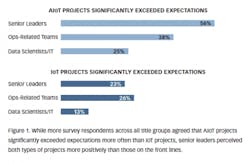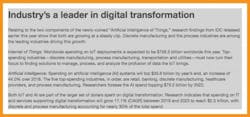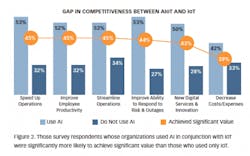By Bob Sperber
When deployed in tandem, artificial intelligence (AI) and the Internet of Things (IoT) can bring powerful new capabilities and competitive advantages—a net effect that is greater than the sum of its constituent parts.
This is the central finding of a new study conducted by SAS, Deloitte and Intel with research from IDC based on survey of 450 global business leaders. Entitled “AIoT: How Leaders Are Breaking Away,” the survey report indicates that this combination of technologies, dubbed the Artificial Intelligence of Things, represents a key competitive advantage that already has passed from pilot-scale tests to early rollouts.
As companies grow into a fuller implementation of IoT, they begin to realize that the tremendous volumes of data generated are difficult to tame. In this context, the combination of AI with IoT is a natural fit for gaining insights that can help advance not just operational goals but business strategy.
Consider some of the findings the research brought to light:
• 99% of respondents said,
in aggregate, the benefits of using AI together with their IoT solutions met or exceeded expectations.
• 90% of respondents who reported heavy use of AI for IoT operations said it exceeded their expectations for value.
• 35% of senior leaders cited increased revenue as the single most important area of improvement they expected to achieve from their IoT efforts.
Overall, projects that combine IoT with AI are having a greater-than-expected impact in operations, the enterprise and ultimately, the bottom line.
The expectations game
It came as a bit of a surprise to IDC’s Maureen Fleming, program vice president for intelligent process automation, that leaders value the addition of AI to IoT projects as highly as the do. She confessed to Smart Industry that in her travels and client encounters, she’s been “barraged” with negative feedback to the point where “it seems like everywhere I go people are talking about the high failure rate of digital transformation efforts.”
Naturally, she expected lower engagement among respondents. “But what we found true is the exact opposite.”
One possible explanation for the surprising, healthy attitude toward this thing called AIoT is that it’s the IT and operations leaders who fret over the details more than the CEO’s office. According to the research, 56% of senior leaders believe their AIoT projects significantly exceeded expectations, a margin 18% greater than operations-related teams and 31% greater than data scientists and IT leaders. Interestingly, operational leaders were the greatest proponents of IoT alone (Figure 1).
Figure 1
“In my experience, senior executives tend to be a lot more optimistic than those at other levels in the organization—it’s kind of a requirement for the job,” says Shak Parran, partner at Deloitte Canada and analytics leader for its Omnia AI practice. Below the top floor, he says, the practical reality of putting these capabilities to work can make data scientists “a little more pessimistic. They know that their data has to be cleaned up, they have to teach machines to do the right things, their processes have to be optimized, and so on. They see the obstacles, because that’s what they’re responsible for navigating.”
The good news is that this attitudinal gap may close over time, if an observation by Melvin Greer, Intel’s chief data scientist, comes to fruition. “Over the past 24-36 months, we’re seen ample evidence of chief data officers moving into the CEO suite.”
A competitive AI-vantage
As implementation teams have matured, so has the likelihood of success with digital transformation initiatives. For successful projects, focus shifts from connecting devices and collecting new and different data to the next step of the journey, analytics. From analytics to the use of AI is another step forward in the ability to filter, correlate and uncover complex relationships. The researchers confirm that industrial firms are indeed moving from proofs of concept and pilot tests to production systems with analytical approaches that incorporate AI.
The key to driving long-term, sustainable value with AIoT lies in building experience with large-scale rollouts, with higher levels of automation, throughout the organization. And the only way to reach that scale with AIoT is to increase the level of automation, according to Oliver Schabenberger, COO and CTO at SAS. “So many CIOs I talk with say automation is a primary focus, to make IoT-related analytics insights consumable by business analysts and others, not just the data scientists.”
In turn, the reason to scale-up and automate is to gain a competitive advantage. And, the report shows, companies that use AI and IoT together are more competitive than those using only IoT.
When asked about their success across six major initiatives—from speeding-up operations to improving productivity and reducing costs—those respondents who used AI in conjunction with IoT said they were significantly more successful than counterparts who used only IoT. For instance, 53% of leaders reported significant value in using AIoT for speeding-up operations as compared to 32% using IoT without AI. Roughly similar numbers hold for initiatives to improve employee productivity, streamline operations and provide new digital services and innovations. In all cases, there was a double-digit gap between users of AIoT and IoT alone (Figure 2).
Figure 2
Of the six initiatives examined, AI was seen to be least important in the area of reducing costs/expenses.
This is not unexpected, according to Jason Mann, vice president of IoT, SAS. Companies are primarily focused on three core business objectives: “achieving higher levels of operational efficiency, improving top-line growth and enhancing customer engagement,” he says. While cost-cutting is important, it’s typically not a strategic business driver.
Companies who refresh their data at least once a day were asked about the role AI plays in rapid, tactical planning. When AI isn’t in play, IoT data is “overwhelmingly” applied to operational decisions (68%); only 12% use IoT for day-to-day planning-oriented decisions. But with the introduction of AI, “the number of respondents using this data for day-to-day planning nearly triples, increasing to 31%.”
IDC’s Fleming, calling this the “most interesting” finding of the study, explained that improving the speed of sensor data refresh combined with AI “expands an organization’s ability to focus on immediate planning, while also quickly identifying and resolving operational problems. The combination produces greater agility and more efficiency.”
More generally, those who use AI this way broaden their toolset to address issues of supply and demand, product quality, merchandising and more, says Intel’s Gadgil: “They’re focusing on issues like productivity, but they’re also looking for the next opportunities for transformation in their business…they’re pushing their organizations to connect the dots and see how some of these new technologies can contribute.”
Increased revenue is job one
Leading companies that use AI to leverage data beyond their own operations and into the supply chain “are better able to drive value back to customers, and build a portfolio of data-driven services,” says Bill Roberts, senior director in SAS’ IoT division. Further, after 12-24 months of using AI + IoT, users reported decreased costs or expenses (85%), improved employee productivity (87%) and streamlined operations (86%).
“Logic and intelligence are now going to be distributed across the architecture, right back into the service center, onto the device or truck or piece of equipment,” Roberts says.
Among the benefits sought for their IoT efforts, increased revenue topped the list for senior leaders across geographies, industries, and companies of all sizes. And if the improved results reported by those who have begun to add AI to their IoT connectivity projects is any indication, the AIoT has a bright future indeed.








